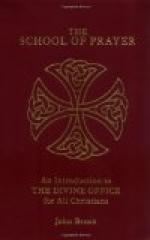Quarter Tenses fall on the Wednesdays, Fridays, and Saturdays after the third Sunday of Advent, after the first Sunday of Lent; after Pentecost Sunday, and after the feast of the exaltation of the Cross.
The Nineteen Years’ Course of the Golden Number. This course or cycle was invented by an Athenian astronomer about 433 B.C. It was not exact, but was hailed with delight by the Greeks, who adorned their temples with the key number, done in gold figures; hence the name. The cycle of course is the revolution of nineteen years, from 1 to 19. When this revolution or course of years is run there is a new beginning in marking, No. 1, e.g., in the year 1577 the nineteenth number, the golden number, was 1; the following year it was 2, and so on until in 1597 the golden number again is 2. A table given in the Breviary shows how the golden number may be found and a short rule for the finding of it in any year is given. To the number of the year (e.g., 1833) add 1; then divide the sum thus resulting by 19 and the remainder is the golden number; if there be no remainder the golden number is 19.
EPACTS AND NEW MOONS.
The Epact (Greek [Greek: epaktos] from [Greek: eapgo] I add) is nothing more than the number of days by which the common solar year of 365 days exceeds the common lunar year of 354 days. So that the epact of the first year is 11, because the common solar year exceeds the common lunar year by 11 days, and these added to the 11 days of the first, produce 22 as the epact. At the end of the second year the new moon falls 22 days sooner than in the first year. The epact of the third year is three, because if 11 be added to the 22, the result is 33, and from this 33 we subtract 30 days which make up a lunar embolism and the remainder gives us 3, the epact for the year, and so on.
In the Breviary there is a table (alia Tabella epactarum) corresponding to the golden numbers from the year 1901 to the year 2000 inclusive. To take away all doubt in the use of this table, a new table of epacts, an example may be quoted. In the year 1901 the epact was X, which is placed under the golden number 2; and new moons appear on the 21st January, 19th February, and 21st March.... Again, in 1911 the epact is not marked by a number, but by an asterisk (see Table in Breviary) which is placed under the golden number 12, and in the calendar for the whole year will indicate the new moon on January 1st, January 31st (for in February there is no new moon indicated in the Table; the sign [*] is not found), on March 1st, March 31st, and on April 29th. In the year 1916 the golden number is 17 and the epact is 25 (written not in Roman numerals but in ordinary figures), the new moons occur on 6th January, 4th February, 6th March, 4th April, etc. For when the epact is 25, corresponding with golden numbers greater than the number 11 in the calendar, we must




